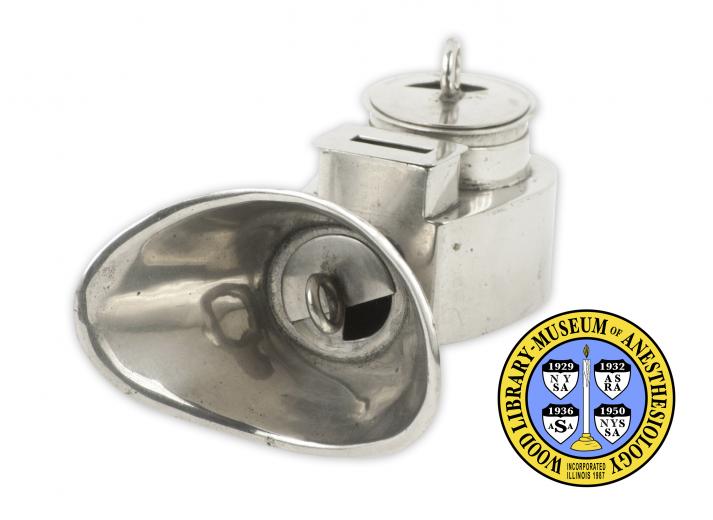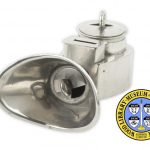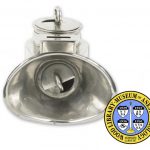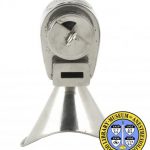Murphy Inhaler
Edward William Murphy (1802-1877) was a London obstetrician who quickly adopted the use of chloroform after its introduction in 1847. While some anesthetic inhalers covered both the nose and the mouth, Murphy’s inhaler utilized a mouthpiece only. Theorizing that a woman could more easily be given an overdose of chloroform with both her nose and mouth covered by the inhaler, Murphy believed his mouthpiece-only inhaler was safer. The flattened, funnel-shaped part is the mouthpiece of the inhaler. It is attached to a compartment with a removable cap. A sponge soaked with ether was inserted into the compartment through this opening. To provide pain relief, Murphy recommended that the woman in labor apply the inhaler to her mouth and inhale just before and during contractions, and but not between contractions. He also advised using chloroform only when the pain became too great.
This Murphy Inhaler was donated in honor of then WLM Librarian Patrick P. Sim, MLS by WLM Honorary Curator George Bause, MD.
Catalog Record: Murphy Inhaler
Access Key: aikg
Accession No.: 2000-06-01-1
Title: [Murphy chloroform inhaler / designed by Edward W. Murphy.]
Author: Murphy, Edward William, 1802-1877.
Publisher: London : Down & Brothers, ca. 1850.
Physical Description: 1 inhaler : nickel plated brass ; 6 x 9 x 13 cm.
Subject: Inhalers, Anesthesia – Great Britain.
Subject: Nonrebreathing Valves.
Subject: Chloroform.
Subject: Anesthesia, Inhalation.
Note Type: General
Notes: Title from the Wood Library Museumís name for the apparatus.
Note Type: Citation
Notes: Murphy EW. Chloroform: Its Properties and Safety in Childbirth. London:
Walton and Maberly, 1855:1.
Note Type: Citation
Notes: Murphy EW. Lectures on Preternatural and Complex Parturition and Lactation.
London: Taylor, Walton and Maberly, 1852:462, 469-470.
Note Type: Physical Description
Notes: Inhaler comprised of a metal, sponge compartment (drum), the outline of which
resembles the curve of a horseshoe; The compartment is flat on the top and
base, rounded at the distal end, and flat where it attaches to a metal
mouthpiece; The sponge compartment is topped by a cylindrical cap that can be
detached to insert or remove the sponge (or absorbent textile); The cap has a
long and narrow rectangular opening for an inspiratory valve; An expiratory
valve is on the upper proximal end of the sponge compartment; The mouthpiece
is the shape of a flattened, funnel; Manufacturerís marking: “Down & Brothers
ñ London”.
Note Type: Reproduction
Notes: Photographed by Mr. William Lyle July 13, 2010.
Note Type: Acquisition
Notes: Donated to the WLM by George S. Bause, M.D. in honor of Mr. Patrick Sim.
Note Type: Historical
Notes: Edward William Murphy (1802-1877) was a London obstetrician who quickly
adopted the use of chloroform in 1847 after James Y. Simpson, M.D.
(1811-1870) first published his experience using the new anesthetic for both
surgical and labor pain (Murphy, 1855). As opposed to an oronasal mask,
Murphyís inhaler utilized a mouthpiece only. Theorizing that a woman could
more easily be given an overdose of chloroform with both her nose and mouth
covered, Murphy believed his mouthpiece-only inhaler was safer (Murphy, 1852)
Murphy recommended that the woman in labor inhale chloroform just before and
during contractions, and but not inbetween (Murphy, 1852). He also advised
using chloroform only when the pain became too great or intolerable: ìIn
natural labour do not interfere so long as the patient can bear her pains
well Ö that is, if she is not teased with short, very severe and very
inefficient pains, you need not give chloroformî (Murphy, 1852).




